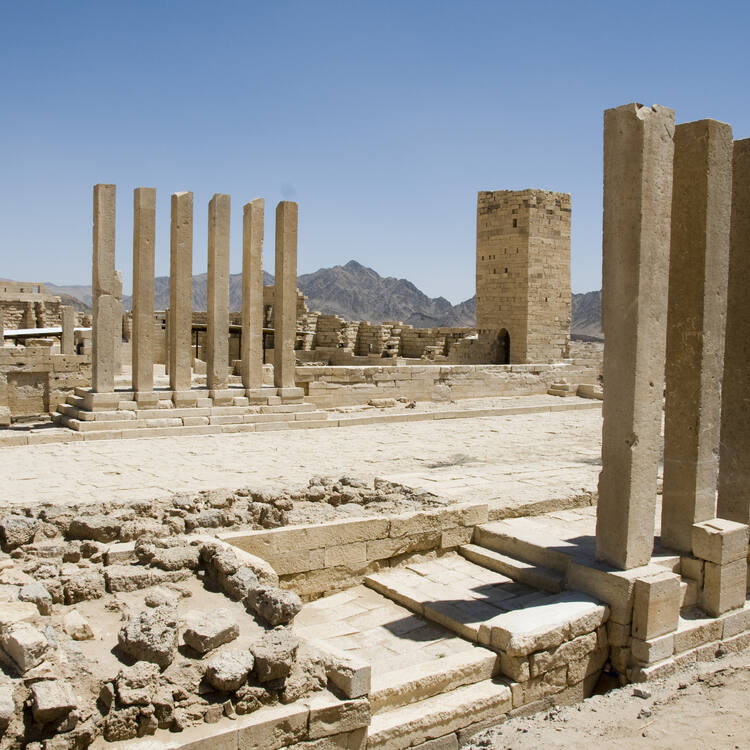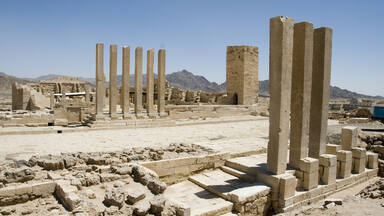Landmarks of the Ancient Kingdom of Saba, Marib
Landmarks of the Ancient Kingdom of Saba, Marib
The Landmarks of the Ancient Kingdom of Saba, Marib, is a serial property comprising seven archaeological sites that bear witness to the rich Kingdom of Saba and its architectural, aesthetic and technological achievements from the 1st millennium BCE to the arrival of Islam around 630 CE. They bear witness to the complex centralized administration of the Kingdom when it controlled much of the incense route across the Arabian Peninsula, playing a key role in the wider network of cultural exchange fostered by trade with the Mediterranean and East Africa. Located in a semi-arid landscape of valleys, mountains and deserts, the property encompasses the remains of large urban settlements with monumental temples, ramparts and other buildings. The irrigation system of ancient Ma'rib reflects technological prowess in hydrological engineering and agriculture on a scale unparalleled in ancient South Arabia, resulting in the creation of the largest ancient man-made oasis.
Description is available under license CC-BY-SA IGO 3.0
Hauts lieux de l'ancien royaume de Saba, Marib
Les hauts lieux de l'ancien royaume de Saba, Marib, sont un bien en série comprenant sept sites archéologiques qui témoignent du riche royaume sabéen et de ses réalisations architecturales, esthétiques et technologiques, du 1er millénaire avant notre ère jusqu’à l'arrivée de l'islam vers l’an 630 de notre ère. Ils témoignent de l'administration centralisée très complexe du Royaume lorsqu'il contrôlait une grande partie de la route de l'encens à travers la péninsule arabique, jouant un rôle clé dans le réseau plus large d'échanges culturels favorisé par le commerce avec la Méditerranée et l'Afrique de l'Est. Situé dans un paysage semi-aride de vallées, de montagnes et de déserts, ce bien englobe les vestiges de grands établissements urbains avec des temples monumentaux, des remparts et d'autres édifices. Le système d'irrigation de l'ancienne Ma'rib reflète des prouesses technologiques en matière d'ingénierie hydrologique et d'agriculture à une échelle inégalée dans l'ancienne Arabie du Sud, qui a permis la création de la plus grande oasis artificielle ancienne.
Description is available under license CC-BY-SA IGO 3.0
Monumentos del antiguo reino de Saba, Marib
Los monumentos del antiguo reino de Saba son un sitio seriado que comprende siete sitios arqueológicos que atestiguan del rico reino de Saba y sus logros arquitectónicos, estéticos y tecnológicos desde el primer milenio antes de nuestra era hasta la llegada del Islam, hacia el año 630 de nuestra era. Atestiguan de la administración centralizada muy compleja del Reino cuando éste controlaba gran parte de la ruta del incienso a través de la Península Arábiga, desempeñando un papel clave en la red más amplia de intercambios culturales favorecidos por el comercio con el Mediterráneo y África Oriental. Situado en un paisaje semiárido de valles, montañas y desiertos, este sitio engloba los vestigios de grandes establecimientos urbanos con templos monumentales, murallas y otros edificios. El sistema de irrigación de la antigua Marib refleja proezas tecnológicas en materia de ingeniería hidrológica y agricultura a una escala sin parangón en la antigua Arabia meridional que permitieron crear el mayor oasis artificial antiguo.
source: UNESCO/CPE
Description is available under license CC-BY-SA IGO 3.0
Outstanding Universal Value
Brief synthesis
The Landmarks of the Ancient Kingdom of Saba represents a period of the South Arabian history from the 1st millennium BCE until the arrival of Islam to the region around 630 CE, when the ancient Yemeni kingdoms developed amidst the harsh and arid environment of the Arabian Peninsula and flourished through their involvement with the Incense Trade Route linking South Arabia to the Mediterranean, from about the 8th century BCE to the 3rd century CE, before it was overpowered by the Ḥimyar people.
Located in the Marib Governorate in central Yemen, seven archaeological sites reflect the affluent Kingdom of Saba, arising from its control of the incense trade in South Arabia and its architectural, aesthetic and technological achievements that bear witness to a highly complex society with a strong, well-organised and centralised administration, as evidenced by numerous historical wall inscriptions.
The Sabaeans' culture and wealth is clearly evident in the ensemble of two cities, temples and extensive irrigation systems. The walled capital city Ma’rib, was the administrative, cultural and economic centre of the Kingdom of Saba, while the fortified city of Sirwah, some forty kilometres to the west, may have acted as its military capital. The monumental sanctuaries with propyla in the temples of Ḥarūnum, Awām and Bar’ān were linked by a processional pilgrimage route, which attracted adherents from across the Arabian Peninsula. Technological knowledge in the field of hydrological engineering enabled the Sabaeans to create the Ma’rib dam, which fed an innovative irrigation system of canals that allowed cultivation of a vast territory spreading north and south of Ma’rib, that was considered to be the largest artificial oasis in ancient Arabia.
Criterion (iii): The Landmarks of the Ancient Kingdom of Saba, with the monumental architecture and the preserved hydraulic structures erected by the Sabaeans, demonstrate high level of technological know-how and engineering skills. They are an exceptional testimony to the affluence of the Kingdom of Saba, which dominated South Arabia in the period between the 8th century BCE to the 3rd century CE as a political and cultural power. They reflect the high socio-political and economic status of the kingdom, which owed its prosperity to control of the incense trade, and its survival in the harsh arid environment of the Arabian Peninsula through the creation of large oases based on a sophisticated irrigation system linked to the Ma’rib dam. The preserved wall inscriptions that document historical events, religious occasions, and administrative decisions offer a glimpse into the main domains of life of the kingdom.
Criterion (iv): The Landmarks of the Ancient Kingdom of Saba with their monumental architecture and diverse technological advances represent an outstanding example of an ensemble that testifies to the cultural tradition of the Kingdom of Saba that served as a central node in the frankincense trade route through the Arabian Peninsula. Flourishing within the semi-arid landscape of valleys, mountains and deserts of South Arabia thanks to a highly advanced irrigation system, the kingdom played a key influential role among neighbouring realms and in the wider network of cultural exchanges at a time when trade routes linked South Arabia with the Mediterranean and East Africa. The dam of the Ma’rib irrigation system, which enabled farming in what is said to be the largest artificial oasis in ancient Arabia, represents the pinnacle of hydrological engineering in the region.
Integrity
The component parts of the property include the attributes necessary to ensure the representation of the features and processes, which convey the property’s Outstanding Universal Value. The physical fabric of the property can be considered as very poor with some attributes having been gravely damaged. Considering the existing threats related to the war and the developmental pressures, integrity of the individual component parts and of the property as a whole can be considered as highly vulnerable.
Authenticity
The authenticity of the individual component parts and of the whole series can be considered as highly vulnerable due to historical developments and contemporary threats. Despite changes in the landscape of the property associated with the development of the modern city of Ma’rib, and the urban sprawl that led to the destruction of some areas with archaeological potential, the historical oasis setting of the component parts can be still understood. Demolishing of post-Sabaean vernacular architecture, which reflects the traditions that link the pre-Islamic Sabaean culture with the cultures that developed in the area after the arrival of Islam, and which constitutes part of the historical context of the property, is of concern.
Management and protection requirements
The archaeological material at all component parts is legally protected at the national level through the Law on Antiquities N. 21/1994 and its amendments set forth by Law N. 8/1997. The ancient city of Ma’rib is protected as a historic town by Law N. 16/2013. The legal authority within the boundaries of the component parts is unclear, as are protection mechanisms that apply to the property. The legal basis for the buffer zones, including buffer zone B, is also not known at this stage.
Protection and management of the property reside at the highest level with the General Organization of Antiquities and Museums; the Ma’rib branch being responsible for the monitoring and maintenance of the component parts. The General Organization for the Preservation of Historic Cities in Yemen is in charge of the protection and management of the ancient city of Ma’rib as a historic town. Besides the legal-institutional protection, the component parts benefit from traditional protection provided by the local tribes.
At present, there is no management plan for the property in place. Conservation and Management Guidelines have been developed to guide future management and protection of the component parts. But it is unclear how the proposed plan of action will be implemented given the precarious political situation. The management measures for the buffer zones, including buffer zone B, have not been provided.

